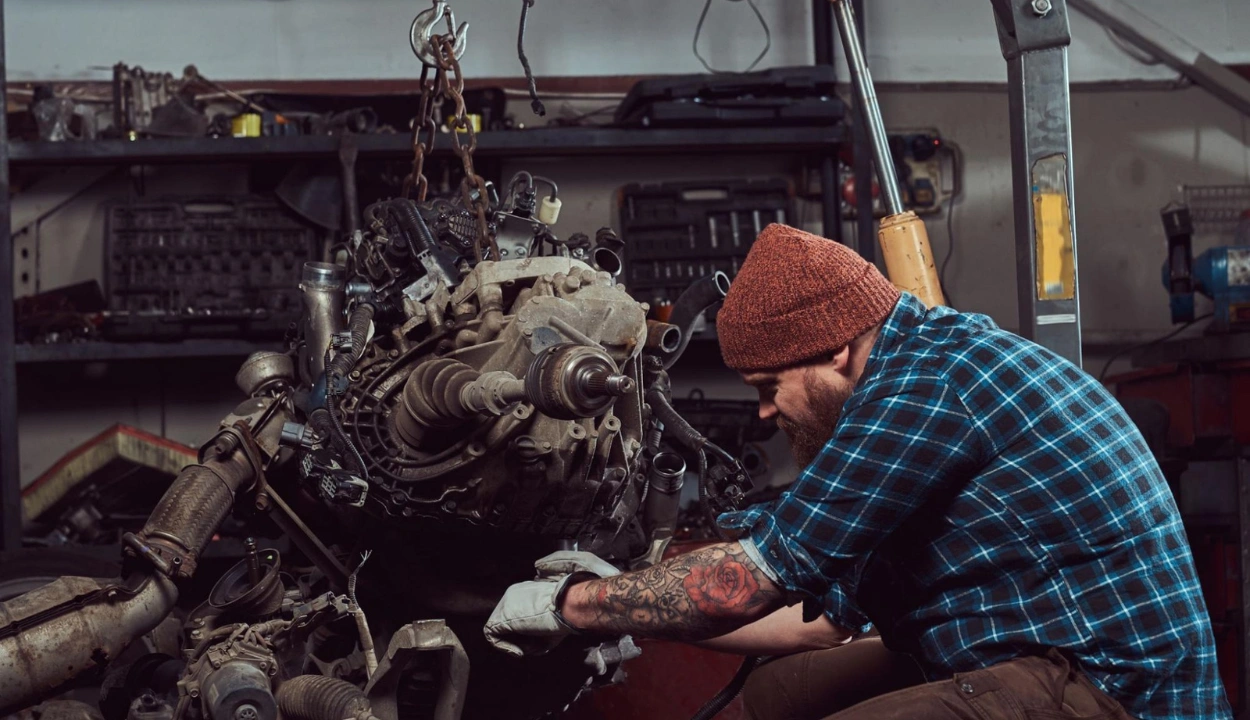Preventive vs. Reactive Maintenance: What's Best for Construction Equipment?
Effective equipment maintenance is pivotal in construction management, and new software solutions are revolutionizing field operations by enhancing efficiency and minimizing project downtime.
By leveraging the principles of preventive vs. reactive maintenance and utilizing data-driven maintenance schedules, Clue minimizes downtime and maximizes efficiency, ensuring a significant boost in profits.
What is Preventive Maintenance?

Preventive maintenance is the process of taking effective steps to keep vehicles running well and lasting longer. It involves regularly checking and fixing important parts like oil, spark plugs, hoses, filters, brakes, and the overall engine.
Following a schedule for preventative maintenance helps ensure that vehicles stay safe and cost-effective over time.
In addition to reducing the chances of unexpected breakdowns, this strategy also improves fuel efficiency and reduces the risks of violations during fleet roadside inspections.
It ensures compliance with regulations and guarantees that vehicles are reliable whenever they are on the road.
Understanding the benefits of preventive vs. reactive maintenance can help fleet managers make informed decisions to maintain vehicle performance and reliability.
Benefits
1. Cost Savings Over Time
Regular maintenance saves money in the long run by preventing costly problems in the future. It extends the lifespan of machines, enhances their performance, and reduces downtime.
Proficient construction equipment maintenance software helps manage maintenance costs effectively.
2. Extended Equipment Lifespan
A regular equipment maintenance program extends the lifespan of equipment by adhering to schedules, making it more dependable and less prone to breakdowns. This approach saves money on repairs and keeps projects on track, thereby improving overall productivity.
3. Increased Safety
Scheduled maintenance makes workplaces safer by keeping machines in good shape and lowering the chances of breakdowns and accidents. It meets safety rules and provides a reliable environment for workers to do their jobs safely.
4. Minimization of Downtime
Preventative maintenance cuts downtime by fixing problems early, often when it's least disruptive. This saves time and resources, making construction projects run more smoothly.
Clue's automated equipment maintenance scheduling feature ensures that maintenance occurs at optimal times, which helps prevent expensive breakdowns and reduces downtime a lot.
Challenges
1. Higher Upfront Costs
Implementing preventive maintenance demands significant investments in resources like CMMS setup and specialized tools.
For small businesses, these upfront costs can strain asset management budgets, despite long-term benefits in minimizing downtime.
2. Potential Over-Maintenance
Preventive maintenance can lead to inefficiencies and higher costs through unnecessary activities.
Balancing it with reactive strategies optimizes equipment reliability and operational costs, prioritizing based on business impact and equipment longevity.
What is Reactive Maintenance?

Reactive maintenance is a method used to address problems, such as equipment failure when they occur.
It often results from neglecting regular inspections, leading to breakdowns and failures that require immediate attention.
This method tends to be more costly due to repair bills, lost time while the vehicle is out of service, and potential damage to the vehicle over time, which affects its performance and lifespan.
While reactive maintenance cannot always be avoided, regular upkeep can help reduce its negative impact.
Benefits
These are the few advantages of reactive maintenance:
1. Lower Initial Costs
One major advantage of reactive maintenance is its lower upfront costs.
Unlike preventive maintenance, which involves regular inspections and preemptive repairs, reactive maintenance addresses issues only as they occur, saving immediate expenses on scheduled maintenance.
2. Simplicity in Planning
Reactive maintenance is easier to plan because it doesn't need much scheduling or preparation.
It responds to issues as they arise without prior arrangement, so there's no need to set aside specific times for inspections or repairs.
This simplicity can lighten the load of organizing maintenance tasks.
Challenges
The following are the major disadvantages of reactive maintenance:
Higher Long-term Costs
Reactive maintenance brings about greater costs because of frequent fixes, overtime wages and immediate part deliveries.
When preventative maintenance is neglected, wear and tear accelerates, necessitating more frequent and pricey repairs that ultimately have an effect on budgets and profitability.
Increased Downtime
Reactive maintenance can excessively increase downtime due to unpredicted equipment failures which can hinder the production schedules and also affect the manufacturing processes.
This downtime in turn severely affects productivity and disrupts the supply chain which leads to missed deadlines and lost revenue, specifically in the industries which require continuous operation.
Safety Risks
Poorly maintained equipment poses significant risks, including unexpected breakdowns and accidents.
Regular maintenance ensures reliable operation, enhancing workplace safety and minimizing risks.
Comparative Analysis: Preventive vs. Reactive Maintenance

Preventive Maintenance
Short-Term Costs
1. Initial Investment: Developing a preventive maintenance plan, purchasing necessary tools, and setting up systems can vary widely.
2. Regular Inspections and Servicing: These recurring costs can include labor, parts, and materials.
A report by the U.S. Department of Energy says that preventive maintenance can save up to 12 or 18% on annual operating costs compared to reactive maintenance. For example, if the cost of reactive maintenance annually is $300,000, preventive maintenance might cost around $264000.
Long-Term Costs
1. Reduced Major Repairs: By preventing large-scale failures, organizations can save major repair expenses.
2. Extended Equipment Lifespan: Regular maintenance can broaden the lifecycle of equipment by up to 20-40%
3. Operational Efficiency: Keeping up with proficiency and minimizing downtime can prompt significant savings in operational costs.
Reactive Maintenance
Short-Term Costs
1. Lower Initial Expenditure: In contrast to preventive maintenance, regular maintenance is not required, resulting in lower initial costs.
2, Unplanned Downtime: The cost of downtime can be substantial, especially if the equipment is critical to operations. For example, according to a study by ITIC, 98% of organizations say a single hour of downtime costs over $100,000.
3. Emergency Repairs: Costs can include extra charges for fast shipping of parts and higher wages for overtime work. Emergency maintenance can cost up to three times more than planned maintenance due to the urgency and unplanned nature of the repairs.
Long-Term Costs of Reactive Maintenance
1. Frequent Major Repairs: Without regular maintenance, equipment fails more often and more severely. Unplanned reactive maintenance can cost two to five times more than scheduled maintenance.
2. Reduced Equipment Lifespan: When equipment is not regularly inspected, they end up wearing out faster and will need replacement more frequently. A study revealed that poor maintenance can shorten the life of equipment by 20%
3. Operational Inefficiencies: Unplanned downtime can easily disrupt operations and can lead to major financial losses. The average expense of downtime across industries is about $300,000.
Impact on Equipment Lifespan
The maintenance process used for construction equipment can greatly affect its performance, its reliability, and lastly, its lifespan. An equipment's life is affected differently by each of the two main types of maintenance strategies.
Preventive Maintenance
To keep the equipment working smoothly and avoid major problems, a preventive maintenance approach includes regular maintenance, part replacement and servicing.
- Extended Lifespan: Preventive maintenance is capable of extending the equipment's life by identifying and fixing all minor issues early. This eases operations, prevents overheating, and improves the overall performance.
- Cost Efficiency: Scheduled maintenance lowers repair costs through early detection, minimizing urgent repairs and downtime. It helps plan and budget for costs, avoiding financial stress from unexpected breakdowns and enhances equipment longevity and cost-effectiveness.
Reactive Maintenance
Reactive maintenance, also known as "run-to-failure" maintenance, involves fixing equipment only after it breaks down or shows signs of failure. This strategy does not include regular inspections or servicing.
- Reduced Lifespan: Reactive maintenance makes equipment prone to more damage by letting it run until it breaks down, which shortens its lifespan. Unexpected breakdowns also cause more wear and tear, leading to higher overall maintenance costs.
- Higher Costs: This leads to higher costs due to expensive repairs from extensive damage and loss of productivity caused by unplanned downtime, resulting in project delays and rental expenses for replacement equipment.
Safety Considerations
Preventive Maintenance
Regular equipment checks and maintenance provide safety compliance which prevents accidents and legal issues on construction sites. They make sure equipment is safe, meets regulations, and keeps projects reliable and lawful.
Reactive Maintenance
Equipment not regularly maintained poses higher accident risks due to unexpected failures, increasing injuries. Reactive maintenance can lead to safety standard violations, resulting in fines and legal issues.
Choosing the Best Strategy: Preventive vs. Reactive Maintenance
Factors to Consider
When choosing the best maintenance strategy for any operation, several crucial factors must be carefully evaluated. These include equipment type, budget constraints, and risk tolerance levels.
- Equipment Type: The nature of the equipment dictates the maintenance strategy. Complex, critical machines benefit from proactive maintenance to prevent costly breakdowns. Simpler equipment may use reactive maintenance, posing minimal impact on operations.
- Budget: Financial resources influence strategy selection. Preventive maintenance saves money in the long run by preventing breakdowns, but it must be paid for up front. Although it may initially appear to be less expensive, reactive maintenance can result in increased costs due to unexpected failures and urgent repairs.
- Risk Tolerance: Organizations may vary in their risk tolerance. High-stakes industries like healthcare and aviation go for preventive maintenance to reduce risks of unexpected failures.
Combining Approaches
Combining preventive and reactive methods makes a fair strategy that utilizes the best of the two techniques.
Benefits of Integrating Preventive and Reactive Maintenance
- Cost Efficiency: Checking the equipment regularly reduces breakdowns and the need for unexpected repairs and downtime.
- Improved Equipment Reliability: Leading routine checks assures that equipment keeps on working appropriately, making it less likely to break out of the blue and broadening its lifespan.
- Flexibility and Quick Response: Reactive maintenance rapidly fixes abrupt breakdowns and keeps the work on target without delays in production or service.
- Efficient Resource Use: Using both methods lets resources be used well. Regular checks happen when things are quiet, and reactive fixes using resources only when needed.
- Better Risk Control: Doing both types of maintenance lowers risks. Regular checks catch common problems, and quick fixes handle surprises, making overall risk management stronger.
A construction equipment management software combines both preventive and reactive maintenance to manage tasks accurately. This helps cut downtime and costs while making equipment more reliable and resilient with proactive fixes and quick responses to issues.
Conclusion
When choosing between preventive and reactive maintenance for construction equipment, it's about finding a balance.
Preventive maintenance prevents problems and saves money over time, while reactive maintenance offers flexibility and reduces immediate costs.
Clue enables a customized approach by streamlining maintenance schedules and delivering actionable equipment insights, ensuring smooth operations and extended equipment longevity.
FAQs
What is Preventive Maintenance?
Preventive maintenance is a method of regular inspection and fixing construction equipment early including oil, brakes and spark plugs. This keeps the equipment operating swiftly and expands its life preventing unexpected breakdowns.
What are the Benefits of Preventive Maintenance?
A significant benefit of preventative maintenance is that it prevents major repairs and minimizes equipment downtime. By doing so, it saves money and improves safety and reliability, which are essential for smooth construction operations. Construction asset tracking software further boosts efficiency by simplifying maintenance schedules and ensuring timely inspections, optimizing equipment performance and project workflow.
What is Reactive Maintenance?
Reactive maintenance fixes equipment problems only when they happen, rather than preventing them beforehand. It focuses on quick fixes after breakdowns, which can be costly due to urgent repairs and equipment downtime.
Why Consider Integrating Preventive and Reactive Maintenance?
Combining preventive and reactive maintenance gives the best of both worlds. It means checking equipment regularly to catch problems early, while also being ready to fix issues quickly when they arise. This approach makes construction operations more efficient and saves money by reducing downtime.
Transform Your Equipment Management












